The global AI waste sorting robots market is valued at USD 84.6 million in 2025 and is set to reach USD 211.6 million by 2035, recording an absolute increase of USD 127.0 million over the forecast period. This translates into a total growth of 150.1%, with the market forecast to expand at a compound annual growth rate (CAGR) of 9.6% between 2025 and 2035.
The market size is expected to grow by approximately 2.5X during the same period, supported by increasing demand for automated waste management solutions, growing adoption of artificial intelligence in recycling operations, and rising requirements for efficient sorting systems across municipal waste facilities, industrial recycling centers, and commercial waste processing operations.
Between 2025 and 2030, the AI waste sorting robots market is projected to expand from USD 84.6 million to USD 138.4 million, resulting in a value increase of USD 53.8 million, which represents 42.4% of the total forecast growth for the decade.
This phase of development will be shaped by increasing demand for precision sorting solutions, rising municipal waste volumes enabling advanced automation techniques, and growing availability of machine learning technologies across commercial recycling operations and industrial waste processing facilities.
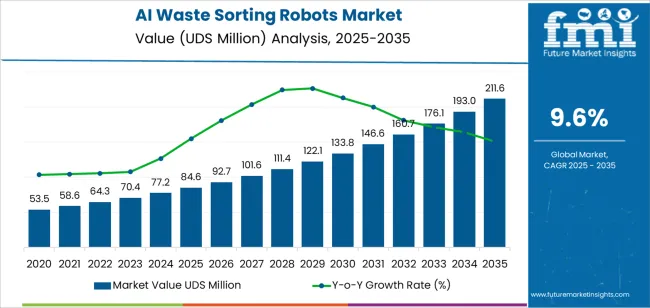
Between 2030 and 2035, the market is forecast to grow from USD 138.4 million to USD 211.6 million, adding another USD 73.2 million, which constitutes 57.6% of the ten-year expansion. This period is expected to be characterized by the advancement of computer vision systems, the integration of robotic process automation for material handling, and the development of premium AI algorithms across diverse waste sorting applications.
The growing emphasis on circular economy principles and waste diversion optimization will drive demand for advanced robotic varieties with enhanced recognition capabilities, improved sorting accuracy characteristics, and superior processing throughput profiles.
| Metric | Value |
|---|---|
| Estimated Value in (2025E) | USD 84.6 million |
| Forecast Value in (2035F) | USD 211.6 million |
| Forecast CAGR (2025 to 2035) | 9.6% |
From 2030 to 2035, the market is forecast to grow from USD 138.4 million to USD 211.6 million, adding another USD 73.2 million, which constitutes 57.6% of the ten-year expansion. This period is expected to be characterized by the advancement of deep learning recognition systems, the integration of automated material handling accessories for processing efficiency, and the development of specialized robotic configurations for enhanced sorting patterns. The growing emphasis on facility automation and operational precision will drive demand for premium varieties with enhanced contamination detection credentials, improved multi-material compatibility options, and superior functionality characteristics.
Between 2020 and 2024, the AI waste sorting robots market experienced robust growth, driven by increasing awareness of waste management efficiency benefits and growing recognition of robotic systems' effectiveness in supporting efficient recycling operations across municipal facilities and commercial waste processing services. The market developed as operators recognized the potential for specialized AI technologies to deliver productivity advantages while meeting modern requirements for consistent sorting quality and reliable equipment performance. Technological advancement in neural network processing and quality assurance systems began emphasizing the critical importance of maintaining accuracy standards while extending robot service life and improving customer satisfaction across diverse waste management applications.
Market expansion is being supported by the increasing global demand for efficient waste management solutions and the corresponding shift toward high-performance robotic systems that can provide superior operational characteristics while meeting facility requirements for equipment reliability and cost-effective processing methods. Modern waste management operators are increasingly focused on incorporating AI systems that can enhance productivity while satisfying demands for consistent, precisely controlled sorting patterns and optimized material recovery practices. AI waste sorting robots' proven ability to deliver operational efficiency, contamination reduction, and diverse application possibilities makes them essential components for recycling facilities and quality-conscious waste management professionals.
The growing emphasis on precision sorting and facility automation is driving demand for high-performance robotic systems that can support distinctive processing outcomes and comprehensive contamination control across municipal recycling, industrial waste management, and specialty material recovery applications. Facility preference for robots that combine functional excellence with operational flexibility is creating opportunities for innovative implementations in both traditional and emerging waste processing applications. The rising influence of automated waste processing and advanced AI technologies is also contributing to increased adoption of specialized robots that can provide authentic performance benefits and reliable operational characteristics.
The market is segmented by technology type, application, material handling capacity, deployment model, and region. By technology type, the market is divided into visual identification systems, sensor-based sorting, multi-spectral imaging, deep learning algorithms, and others. Based on application, the market is categorized into municipal waste processing, industrial recycling, construction waste sorting, electronic waste processing, and others. By material handling capacity, the market includes light-duty robots, medium-duty systems, heavy-duty processors, and ultra-high capacity units. By deployment model, the market encompasses fully automated systems, semi-automated configurations, and hybrid operational models. Regionally, the market is divided into North America, Europe, Asia Pacific, Latin America, Middle East & Africa, and other regions.
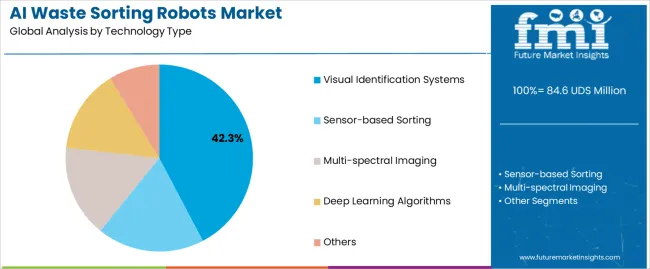
The visual identification systems segment is projected to account for 42.3% of the AI waste sorting robots market in 2025, reaffirming its position as the leading technology category. Facility operators and waste management professionals increasingly utilize visual identification systems for their superior recognition characteristics, established accuracy standards, and essential functionality in diverse sorting applications across multiple material types. Visual identification systems' proven performance characteristics and established cost-effectiveness directly address facility requirements for reliable robot operation and optimal sorting precision in commercial applications.
This technology segment forms the foundation of modern AI waste sorting performance patterns, as it represents the component category with the greatest operational impact potential and established compatibility across multiple robot systems. Business investments in advanced computer vision technology and performance optimization continue to strengthen adoption among efficiency-conscious facility operators. With facilities prioritizing sorting consistency and equipment reliability, visual identification systems align with both productivity objectives and accuracy requirements, making them the central component of comprehensive waste processing strategies.
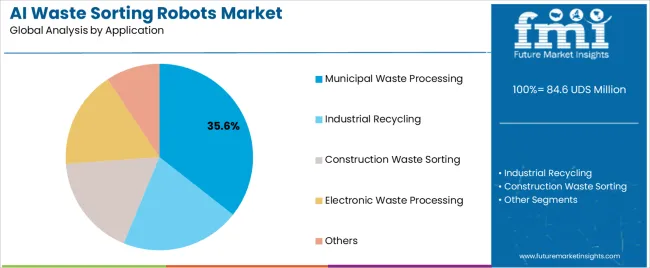
Municipal waste processing is projected to represent 35.6% of the AI waste sorting robots market in 2025, underscoring its critical role as the primary application for quality-focused facilities seeking superior sorting efficiency benefits and enhanced processing completion credentials. Municipal operators and waste management professionals prefer municipal applications for their established processing volumes, proven market demand, and ability to maintain exceptional sorting quality while supporting versatile material requirements during diverse waste processing operations. Positioned as essential applications for performance-conscious facilities, municipal offerings provide both operational excellence and competitive positioning advantages.
The segment is supported by continuous improvement in AI technology and the widespread availability of established processing standards that enable quality assurance and premium positioning at the facility level. Municipal companies are optimizing robot selections to support processing differentiation and competitive efficiency strategies. As AI technology continues to advance and facilities seek efficient sorting methods, municipal applications will continue to drive market growth while supporting business development and operational satisfaction strategies.
The AI waste sorting robots market is advancing rapidly due to increasing waste management efficiency consciousness and growing need for precision sorting solutions that emphasize superior performance outcomes across municipal segments and industrial applications. The market faces challenges, including competition from traditional sorting methods, equipment investment complexities, and technology cost pressures affecting operational economics. Innovation in machine learning integration and advanced sensor systems continues to influence market development and expansion patterns.
Expansion of Municipal and Industrial Processing Applications
The growing adoption of AI waste sorting robots in municipal facilities and industrial processing operations is enabling operators to develop sorting strategies that provide distinctive efficiency benefits while commanding competitive positioning and enhanced processing completion characteristics. Municipal applications provide superior accuracy consistency while allowing more sophisticated contamination control features across various material categories. Facilities are increasingly recognizing the operational advantages of robotic positioning for premium sorting outcomes and efficiency-conscious processing integration.
Integration of Machine Learning and Advanced Recognition Systems
Modern AI waste sorting robot manufacturers are incorporating advanced machine learning technologies, computer vision control systems, and automated performance tracking to enhance operational precision, improve equipment accuracy, and meet commercial demands for intelligent sorting solutions. These systems improve operational effectiveness while enabling new applications, including predictive maintenance programs and performance optimization protocols. Advanced AI integration also allows facilities to support productivity leadership positioning and quality assurance beyond traditional waste processing operations.
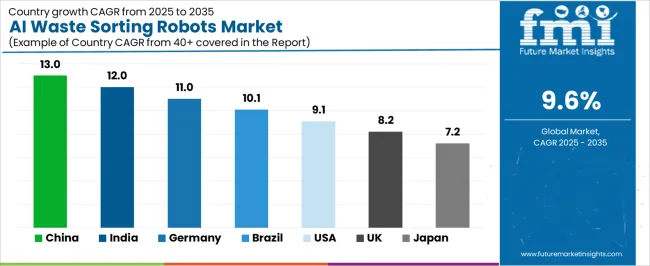
| Country | CAGR (2025 to 2035) |
|---|---|
| China | 13 % |
| India | 12 % |
| Germany | 11 % |
| Brazil | 10.1% |
| USA | 9.1% |
| UK | 8.2% |
| Japan | 7.2% |
The AI waste sorting robots market is experiencing robust growth globally, with China leading at a 13.0% CAGR through 2035, driven by the expanding waste management infrastructure, growing municipal processing requirements, and increasing adoption of automated sorting systems. India follows at 12.0%, supported by rising urbanization development, expanding industrial sector, and growing acceptance of efficient waste processing solutions. Germany shows growth at 11.0%, emphasizing established recycling capabilities and comprehensive AI technology development. Brazil records 10.1%, focusing on municipal expansion and industrial waste processing growth. The USA demonstrates 9.1% growth, prioritizing advanced sorting technologies and facility optimization.
The report covers an in-depth analysis of 40+ countries, with top-performing countries are highlighted below.
Revenue from AI waste sorting robots consumption and deployment in China is projected to exhibit exceptional growth with a CAGR of 13.0% through 2035, driven by the country's rapidly expanding waste management sector, favorable government policies toward environmental protection, and initiatives promoting advanced sorting technologies across major urban regions. China's position as a leading manufacturing hub and increasing focus on automated waste processing systems are creating substantial demand for high-quality AI waste sorting robots in both domestic and municipal markets. Major waste management companies and processing facilities are establishing comprehensive robotic capabilities to serve growing demand and emerging market opportunities.
Demand for AI waste sorting robots products in India is growing at a CAGR of 12.0%, supported by rising municipal investment, growing industrial development, and expanding waste processing facility capabilities. The country's developing recycling sector and increasing commercial investment in advanced sorting technologies are driving demand for AI waste sorting robots across both traditional and modern processing applications. International equipment companies and domestic distributors are establishing comprehensive operational networks to address growing market demand for quality robots and efficient sorting solutions.
Revenue from AI waste sorting robots products in Germany is expanding at a CAGR of 11.0% through 2035, supported by the country's mature recycling sector, established waste management standards, and leadership in automation technology. Germany's sophisticated industrial infrastructure and strong support for advanced sorting systems are creating steady demand for both traditional and innovative robotic varieties. Leading equipment manufacturers and specialty distributors are establishing comprehensive operational strategies to serve both domestic markets and growing export opportunities.
Demand for AI waste sorting robots products in Brazil is projected to grow at a CAGR of 10.1% through 2035, driven by the country's emphasis on municipal expansion, industrial development, and growing waste processing facility capabilities. Brazilian operators and waste management companies consistently seek commercial-grade robots that enhance processing efficiency and support operational excellence for both traditional and modern sorting applications. The country's position as a Latin American waste management leader continues to drive innovation in specialized robotic applications and commercial equipment standards.
Revenue from AI waste sorting robots products in the USA is anticipated to expand at a CAGR of 9.1% through 2035, supported by the country's emphasis on sorting technology advancement, facility optimization, and advanced automation integration requiring efficient robotic solutions. American facilities and industrial users prioritize performance reliability and operational precision, making specialized robots essential components for both traditional and modern waste processing applications. The country's comprehensive technology leadership and advancing processing patterns support continued market expansion.
Demand for AI waste sorting robot products in the UK is projected to grow at a CAGR of 8.2% through 2035, supported by established waste management standards, mature facility markets, and emphasis on equipment reliability across commercial and industrial sectors. British facilities and waste processing professionals prioritize quality performance and operational consistency, creating steady demand for premium robotic solutions. The country's comprehensive market maturity and established processing practices support continued development in specialized applications.
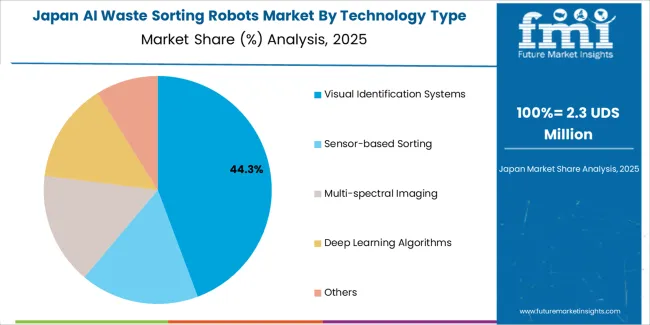
Revenue from AI waste sorting robots products in Japan is expanding at a CAGR of 7.2% through 2035, supported by the country's emphasis on precision manufacturing, quality excellence, and advanced technology integration requiring efficient robotic solutions. Japanese businesses and industrial users prioritize technical performance and manufacturing precision, making specialized robots essential components for both traditional and modern waste processing applications. The country's comprehensive quality leadership and advancing processing patterns support continued market expansion.
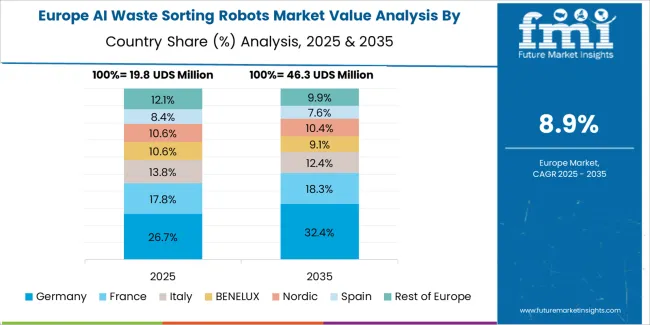
The Europe AI waste sorting robots market is projected to grow from USD 25.8 million in 2025 to USD 58.7 million by 2035, recording a CAGR of 8.6% over the forecast period. Germany leads the region with a 38.4% share in 2025, moderating slightly to 37.8% by 2035, supported by its strong industrial base and demand for premium, technically advanced robotic sorting systems. The United Kingdom follows with 22.1% in 2025, easing to 21.7% by 2035, driven by a mature waste management market and emphasis on equipment reliability and performance optimization.
France accounts for 15.2% in 2025, rising to 15.8% by 2035, reflecting steady adoption of automated sorting solutions and operational efficiency enhancement. Italy holds 11.8% in 2025, expanding to 12.4% by 2035 as municipal waste processing and specialty sorting applications grow. Spain contributes 7.3% in 2025, growing to 7.6% by 2035, supported by expanding waste management sector and equipment modernization. The Nordic countries rise from 3.7% in 2025 to 3.9% by 2035 on the back of strong technology adoption and advanced processing methodologies. BENELUX remains at 1.5% share across both 2025 and 2035, reflecting mature, efficiency-focused industrial markets.
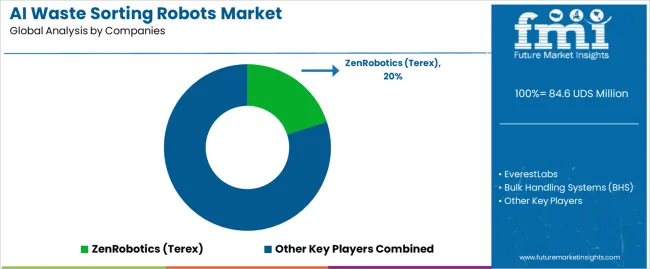
The AI waste sorting robots market is characterized by competition among established automation manufacturers, specialized AI technology producers, and integrated waste management solution companies. Companies are investing in machine learning technologies, advanced sensor development systems, product innovation capabilities, and comprehensive distribution networks to deliver consistent, high-quality, and reliable AI waste sorting robotic systems. Innovation in accuracy enhancement, processing optimization, and application-specific product development is central to strengthening market position and customer satisfaction.
ZenRobotics (Terex) leads the market with a strong focus on waste processing innovation and comprehensive AI waste sorting robotic solutions, offering commercial automation systems with emphasis on manufacturing excellence and technological heritage. EverestLabs provides specialized sorting technologies with a focus on industrial market applications and performance engineering networks. Bulk Handling Systems (BHS) delivers integrated waste processing solutions with a focus on facility positioning and operational efficiency. AMP Robotics specializes in comprehensive sorting equipment with an emphasis on precision applications. Recycleye focuses on comprehensive industrial waste processing robots with advanced design and premium positioning capabilities.
The success of AI waste sorting robots in meeting commercial waste management demands, facility-driven efficiency requirements, and performance integration will not only enhance processing quality outcomes but also strengthen global equipment manufacturing capabilities. It will consolidate emerging regions' positions as hubs for efficient robotic production and align advanced economies with commercial waste processing systems. This calls for a concerted effort by all stakeholders -- governments, industry bodies, manufacturers, distributors, and investors. Each can be a crucial enabler in preparing the market for its next phase of growth.
| Items | Values |
|---|---|
| Quantitative Units (2025) | USD 84.6 m illion |
| Technology Type | Visual Identification Systems, Sensor-based Sorting, Multi-spectral Imaging, Deep Learning Algorithms, Others |
| Application | Municipal Waste Processing, Industrial Recycling, Construction Waste Sorting, Electronic Waste Processing, Others |
| Material Handling Capacity | Light-duty Robots, Medium-duty Systems, Heavy-duty Processors, Ultra-high Capacity Units |
| Deployment Model | Fully Automated Systems, Semi-automated Configurations, Hybrid Operational Models |
| Regions Covered | North America, Europe, Asia Pacific, Latin America, Middle East & Africa, Other Regions |
| Countries Covered | China, India, Germany, Brazil, United States, United Kingdom, Japan, and 40+ countries |
| Key Companies Profiled | ZenRobotics (Terex), EverestLabs, Bulk Handling Systems (BHS), AMP Robotics, Recycleye, and other leading AI waste sorting robot companies |
| Additional Attributes | Dollar sales by technology type, application, material handling capacity, deployment model, and region; regional demand trends, competitive landscape, technological advancements in robotic engineering, precision sorting initiatives, accuracy enhancement programs, and premium product development strategies |
The global AI waste sorting robots market is estimated to be valued at USD 84.6 uds million in 2025.
The market size for the AI waste sorting robots market is projected to reach USD 211.6 million by 2035.
The AI waste sorting robots market is expected to grow at a 9.6% CAGR between 2025 and 2035.
The key product types in AI waste sorting robots market are visual identification systems , sensor-based sorting, multi-spectral imaging, deep learning algorithms and others.
In terms of application, municipal waste processing segment to command 35.6% share in the AI waste sorting robots market in 2025.






Full Research Suite comprises of:
Market outlook & trends analysis
Interviews & case studies
Strategic recommendations
Vendor profiles & capabilities analysis
5-year forecasts
8 regions and 60+ country-level data splits
Market segment data splits
12 months of continuous data updates
DELIVERED AS:
PDF EXCEL ONLINE
Airport Ground Transportation Market Forecast and Outlook 2025 to 2035
AI Image Editor Market Forecast and Outlook 2025 to 2035
Airless Sprayer Accessories Market Size and Share Forecast Outlook 2025 to 2035
Air Purge Valve Market Size and Share Forecast Outlook 2025 to 2035
AI Demand Forecasting Software Market Size and Share Forecast Outlook 2025 to 2035
Air Flow Sensors Market Size and Share Forecast Outlook 2025 to 2035
Air Separation Plant Market Size and Share Forecast Outlook 2025 to 2035
Air Cooled Turbo Generators Market Size and Share Forecast Outlook 2025 to 2035
Aircraft Cooling Turbines Market Size and Share Forecast Outlook 2025 to 2035
Air Conditioning Compressor Market Size and Share Forecast Outlook 2025 to 2035
Air Measuring Equipment Market Size and Share Forecast Outlook 2025 to 2035
Aircraft Smoke Detection and Fire Extinguishing System Market Size and Share Forecast Outlook 2025 to 2035
Aircraft Hose Fittings Market Size and Share Forecast Outlook 2025 to 2035
Aircraft Cabin Interior Market Size and Share Forecast Outlook 2025 to 2035
Aircraft Galley Systems Market Size and Share Forecast Outlook 2025 to 2035
Aircraft Interior Lighting Market Size and Share Forecast Outlook 2025 to 2035
Aircraft Battery Market Size and Share Forecast Outlook 2025 to 2035
Aircraft Floor Panels Market Size and Share Forecast Outlook 2025 to 2035
Aircraft Fuel Systems Market Size and Share Forecast Outlook 2025 to 2035
Aircraft Lubricant Market Size and Share Forecast Outlook 2025 to 2035

Thank you!
You will receive an email from our Business Development Manager. Please be sure to check your SPAM/JUNK folder too.
Chat With
MaRIA